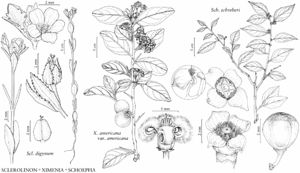Schoepfia
Gen. Pl. 1: 129. 1789.
| Taxon | Illustrator ⠉ | |
|---|---|---|
 | Sclerolinon digynum Ximenia americana var. americana Schoepfia schreberi | John Myers Yevonn Wilson-Ramsey |
Shrubs or trees, branching sympodial on distal shoots, glabrous [hairy]. Leaves: blade subcoriaceous, surfaces glabrous. Inflorescences: peduncle base with persistent imbricate bracts. Pedicels absent [present]. Flowers sweetly fragrant; epicalyx 3-lobed; nectary annular, fleshy, covering ovary distally; corolla cylindric, subcampanulate, or urceolate, lobes reflexed; filaments short, arising proximal to post-staminal hairs. Drupes subtended by persistent epicalyx, with remains of nectary and corolla at apex. x = 12.
Distribution
Fla., Mexico, West Indies, Central America, South America, Asia
Discussion
Species 25 (1 in the flora).
Twenty species of Schoepfia are Neotropical (H. Sleumer 1984) and are classified in section Schoepfia; five species are in sections Schoepfiopsis (Miers) Engler and Alloschoepfia Sleumer of Asia (Sleumer 1935; K. R. Robertson 1982).
Selected References
None.